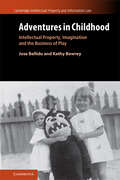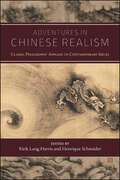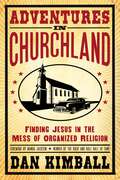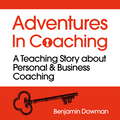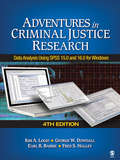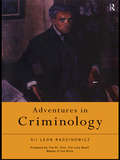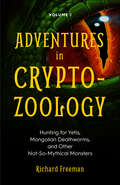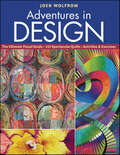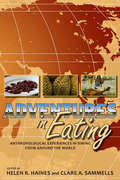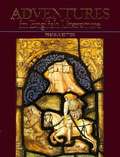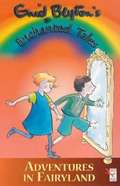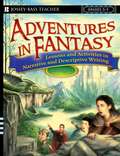- Table View
- List View
Adventures in Childhood: Intellectual Property, Imagination and the Business of Play (Cambridge Intellectual Property and Information Law #61)
by Kathy Bowrey Jose BellidoAdventures in Childhood connects modern intellectual property law and practice with a history of consumption. Structured in a loosely chronological order, the book begins with the creation of a children's literature market, a Christmas market, and moves through character merchandising, syndicated newspaper strips, film, television, and cross-industry relations, finishing in the 1970s, by which time professional identities and legal practices had stabilized. By focusing on the rise of child-targeted commercial activities, the book is able to reflect on how and why intellectual property rights became a defining feature of 20th century culture. Chapters trace the commercial empires that grew around Alice in Wonderland, Peter Rabbit, Meccano, Felix the Cat, Mickey Mouse, Peter Pan, Eagle Magazine, Davy Crockett, Mr Men, Dr Who, The Magic Roundabout and The Wombles to show how modern intellectual property merchandising was plagued with legal and moral questions that exposed the tension between exploitation and innocence.
Adventures in Chinese Realism: Classic Philosophy Applied to Contemporary Issues
by Henrique Schneider Eirik Lang HarrisRealism, or Legalism, was once a significant influence in classical Chinese philosophy, later eclipsed by Confucianism. Its ideas, however, remain alive and powerful. Realists propose dealing with real-world problems using real-world instruments, such as incentives, rewards, institutions, and punishments. Adventures in Chinese Realism updates Chinese Realism to explain contemporary political and philosophical issues in a matter-of-fact, thought-provoking way. Contributors to this volume demonstrate how many of the Legalist recipes for creating strength, security, and order can be applied today. In many areas—international relations, corporate ethics, the organization of the public sector, and the roles that bureaucrats and politicians play—Realism offers unique ways to align these inherently particularistic actions with the broader common good.
Adventures in Churchland: Finding Jesus in the Mess of Organized Religion
by Dan Kimball Foreword by Wanda Jackson Member of the Rock Roll Hall of FameWould Jesus Attend Church Today?Among the top ten trends that are changing American life, Time magazine recently listed a rising dissatisfaction with organized religion. Though many people today like Jesus, they are growing tired of traditional religious institutions. Even those who follow Jesus aren't so sure they always like what Christianity and the church represent.For many years, Dan Kimball would have agreed, until an encounter with a small group of Jesus followers started him on a journey that challenged him to rethink everything he had ever assumed about the church. In Adventures in Churchland, Dan invites you to join him as he uncovers what the Bible really says about the church and reminds us that it’s more than just buildings and institutions, it’s a beautiful mess of broken people learning to follow Jesus together. As you journey with Dan, you’ll begin to see the church as Jesus intended it to be: a community of forgiven misfits coming together to serve the world around them with passion, creativity, innovation, and grace. "If you don’t like the church, or if you’re thinking about leaving, please read this book first. Dan’s stories will make you laugh, make you think, and make you appreciate the church like never before." – Mark Batterson, author of The Circle Maker “As a non-Christian, I was inspired and moved, and have been enthusiastically recommending it to my friends. This is a book for everybody." – Mark Frauenfelder, editor-in-chief of MAKE, founder of boingboing.net "Dan encourages us to break through the tension and messiness that church communities inevitably encounter to experience the beauty of being in community and sharing God's infinite love with others." – Zach Lind, drummer, Jimmy Eat World"I am so glad that my friend Dan has written this book, because there is a lot of confusion out there about Jesus and the church." – Wanda Jackson, Queen of Rockabilly and member of the Rock and Roll Hall of Fame
Adventures in Coaching: An extraordinary way to unlock the power of coaching
by Ben Dowman*Discover the power of coaching through an entertaining and lively story that will develop the skills and understanding of how to coach effectively.*In this groundbreaking new approach to learning how to coach, join Alice on an adventure as she learns the fundamental principles of personal and business coaching. Meet a host of fanciful characters who will help you understand how to listen, how to ask questions effectively and how to have a coaching conversation from start to finish.Adventures in Coaching introduces Coaching as an approach for managing people, improving performance and solving problems. Research shows that learning is often better retained when made fun and stimulating. This book delivers the most rigorous and advanced textbook coaching theory, including the GROW model, in a uniquely engaging and mesmerising manner. The structure and sequence of the material is based on a tried and tested progression that the author has refined through his training and workshops with hundreds of people.The book is brought to life through relevant coaching conversations and practical examples as Alice puts her learning into practice. "Why are you talking about me in the third person, Ben? I'm right here." "Alice! Hello. I'm just introducing the book." "Have you said that I'm the star of the story?" "Of course, Alice." "Ben, can I introduce Rita and Ronald?" "Er... well... I'm not sure we should start with talking animals, this is a serious book." "Of course we should. Rita is a turtle who is an expert coach and she taught Ronald and I how to coach. Oh, and Ronald is a fish!" "Thank you, Alice!" Coaching is brought to life when Alice is faced with some tough coaching conversations and she applies her new learning to the clients she works with. Both new and existing coaches, as well as managers and leaders, will improve their skills of listening, asking questions and exploring ideas. "Good job, Ben. I can't wait to tell the story."(P) 2020 Hodder & Stoughton Ltd
Adventures in Coaching: Unlocking the power of personal and business coaching through a captivating story
by Ben Dowman**Discover the power of coaching through an entertaining and lively story that will develop the skills and understanding of how to coach effectively.** In this groundbreaking new approach to learning how to coach, join Alice on an adventure as she learns the fundamental principles of personal and business coaching. Meet a host of fanciful characters who will help you understand how to listen, how to ask questions effectively and how to have a coaching conversation from start to finish.Adventures in Coaching introduces Coaching as an approach for managing people, improving performance and solving problems. Research shows that learning is often better retained when made fun and stimulating. This book delivers the most rigorous and advanced textbook coaching theory, including the GROW model, in a uniquely engaging and mesmerising manner. The structure and sequence of the material is based on a tried and tested progression that the author has refined through his training and workshops with hundreds of people.The book is brought to life through relevant coaching conversations and practical examples as Alice puts her learning into practice. "Why are you talking about me in the third person, Ben? I'm right here." "Alice! Hello. I'm just introducing the book." "Have you said that I'm the star of the story?" "Of course, Alice." "Ben, can I introduce Rita and Ronald?" "Er... well... I'm not sure we should start with talking animals, this is a serious book." "Of course we should. Rita is a turtle who is an expert coach and she taught Ronald and I how to coach. Oh, and Ronald is a fish!" "Thank you, Alice!" Coaching is brought to life when Alice is faced with some tough coaching conversations and she applies her new learning to the clients she works with. Both new and existing coaches, as well as managers and leaders, will improve their skills of listening, asking questions and exploring ideas. "Good job, Ben. I can't wait to tell the story."
Adventures in Coaching: Unlocking the power of personal and business coaching through a captivating story
by Ben DowmanThis enchanting story uses Lewis Carroll's Alice's Adventures in Wonderland to explain personal and business coaching in a magical and entertaining adventure. A host of fanciful characters show readers how to have an effective coaching conversation from start to finish, and to reach real world outcomes in a more transformative way.In this captivating story, Alice finds herself turning into a pizza, going straight to jail on the Monopoly board and embarking on a space flight. Along the way she meets a helpful turtle, a charismatic ladybird and a fox with some personal problems, among a cast of curious characters.Research shows that learning is often better retained when made fun and stimulating. This book delivers the most rigorous and advanced textbook coaching theory, including the GROW model, contracting and feedback, in a uniquely engaging and mesmerising manner. The structure and sequence of the material is based on a tried and tested progression that the author has refined through his training and workshops over many years.This groundbreaking approach to learning to coach will do for coaching what Who Moved My Cheese did for managing change.
Adventures in Computer Science: From Classical Bits to Quantum Bits
by Vicente Moret-BonilloThe main focus of this textbook is the basic unit of information and the way in which our understanding of this has evolved over time. In particular the author covers concepts related to information, classical computing, logic, reversible computing, quantum mechanics, quantum computing, thermodynamics and some artificial intelligence and biology, all approached from the viewpoint of computer sciences. The book begins by asking the following nontrivial question: what is a bit? The author then discusses logic, logic gates, reversible computing and reversible architectures, and the concept of disorder. He then tries to establish the relationship between three essential questions that justify quantum approaches in computer sciences: the energy required to perform a real-life computation, the size of current processors, and the reversibility of quantum operations. Based on these concepts, the author establishes the conditions that justify the use of quantum techniques for certain kinds of computational tasks, and he uses formal descriptions and formal argumentations to introduce key quantum mechanical concepts and approaches. The rest of the book is formally different, focusing on practical issues, including a discussion of remarkable quantum algorithms in a treatment based on quantum circuit theory. The book is valuable for graduate students in computer science, and students of other disciplines who are engaged with physical models of information and computing.
Adventures in Contemporary Electromagnetic Theory
by Akhlesh Lakhtakia Tom G. MackayThis book describes the most recent advances in electromagnetic theory, motivated and partly informed by developments in engineering science and nanotechnology. The collection of chapters provided in this edited book, authored by leading experts in the field, offers a bird’s eye view of recent progress in electromagnetic theory, spanning a wide range of topics of current interest, ranging from fundamental issues to applications.
Adventures in Criminal Justice Research: Data Analysis Using SPSS 15.0 and 16.0 for Windows
by Kim A. Logio Earl R. Babbie Dr George W. Dowdall Frederick S. HalleyThe only book of its kind, this text guides students through the process of conducting criminological data analysis. Used primarily in lab settings, the Fourth Edition of Adventures in Criminal Justice Research, derived from the popular Adventures in Social Research (Babbie et al, Pine Forge Press/SAGE), systematically takes students through a series of investigative adventures. More than 150 screenshots in the text offer clear visual step-by-step instructions to solidify student understanding.New to This EditionIncorporates even more criminal justice exercises, policy-related exercises, and hot criminal justice–related issues throughout the book Includes analysis of criminal justice and other social issues using data from GSS sets, the 2000 Census, the Harvard School of Public Health College Alcohol Survey, and other data sets available to the public through the Internet Offers increased coverage of Web-based surveys and survey softwareAccompanied by High-Quality Ancillaries!A new Student study site at www.sagepub.com/logiostudy features numerous data sets along with online appendices - Appendix A: Sample Journal Article and "How to Read a Research Article", Appendix B: College Alcohol Study Questionnaire, and Appendix C: Chapter Review Quizzes with Answers. Intended Audience This practical textbook is a valuable supplement for courses in Research Methods and/or Statistics in departments of criminal justice or criminology. The only book of its kind, this text guides students through the process of conducting criminological data analysis. Used primarily in lab settings, the of , derived from the popular (Babbie et al, Pine Forge Press/SAGE), systematically takes students through a series of investigative adventures.
Adventures in Criminology
by Sir Leon RadzinowiczSir Leon Radzinowicz is one of the key figures in the development of criminology in the twentieth century. This account of the development of criminology intertwines his personal narrative as a criminologist with the progression of criminology itself. His experience gained from a career which has spanned 70 years since the 1920s, offers a profound overview of how the understanding of crime and criminals, of criminal justice systems and penology has changed, and of the tensions and dilemmas these pose for democratic societies.
Adventures in Cryptozoology Volume 1: Hunting for Yetis, Mongolian Deathworms, and Other Not-So-Mythical Monsters (Adventures In Cryptozoology Ser.)
by Richard FreemanDiscover the history and science behind these (not so) imaginary creatures—and how to search for them yourself. Cryptozoology, the study of hidden, monstrous, and legendary animals, is truly the art of discovering the unknown. Richard Freeman, Zoological Director of Centre for Fortean Zoology, has explored the corners of the five continents in search of creatures that many people believe are non-existent. In this book, he shares the exciting stories of his investigations of the Yeti, Mongolian Deathworm, Loch Ness Monster, Orang-Pendak, Ninki-Naka, and more. Cryptozoologists throughout the years have studied unknown species of reptiles, lake and sea creatures, apes, and hominins. The science and history of this field of study includes examples of creatures that were once thought to be mythological, but that have since been proven to exist. If you&’re ready to begin your search for Sasquatch and learn to hunt monsters, Adventures in Cryptozoology is your guide. In these pages you&’ll find: · Tales of mythical, extinct, and out-of-place creatures · Hints about Bigfoot and other ape-men · And tips for equipping your own cryptozoology adventure, including all the gear, field craft, and resources you&’ll need to record your findings
Adventures in Darkness: Memoirs of an Eleven-Year-Old Blind Boy
by Tom SullivanIn Adventures in Darkness, Tom Sullivan takes readers through the adventures of his monumental eleventh year. Blind since birth, Tom lived in a challenging world of isolation and special treatment. But he was driven to break out and live as sighted people do. This book is a hair-raising, heart-warming experience that culminates in Tom's reliance upon God to realize his dreams of a "normal" life.
Adventures in Design: The Ultimate Visual Guide, 153 Spectacular Quilts, Activities & Exercises
by Joen WolfromBring more beauty and balance to your quilt designs • Everything you need to know about the essentials of good design from an internationally reknowned expert • Learn about the key elements of design and how to apply strategies for success • Practice what you've learned with exercises at the end of each chapter • An inspiring gallery illustrates design concepts by many prominent quilters and artists - including Alex Anderson, Paula Nadelstern, and Ricky Tims - with over 150 images showcasing all styles of quilts and fabric art, from traditional to modern This is the design textbook for quilters. Joen presents the eight elements of design: line, direction, shape, color, value, texture, proportion, and scale. You'll learn how to work with these elements using many guiding design principles, such as unity and balance. Whether you consider yourself to be a quilter, an artist, or a crafter, you can improve your design skills by exploring Joen's fresh, innovative approach.
Adventures in Eating: Anthropological Experiences in Dining from Around the World
by Clare A. Sammells Helen R. HainesAnthropologists training to do fieldwork in far-off, unfamiliar places prepare for significant challenges with regard to language, customs, and other cultural differences. However, like other travelers to unknown places, they are often unprepared to deal with the most basic and necessary requirement: food. Although there are many books on the anthropology of food, Adventures in Eating is the first intended to prepare students for the uncomfortable dining situations they may encounter over the course of their careers. Whether sago grubs, jungle rats, termites, or the pungent durian fruit are on the table, participating in the act of sharing food can establish relationships vital to anthropologists' research practices and knowledge of their host cultures. Using their own experiences with unfamiliar-and sometimes unappealing-food practices and customs, the contributors explore such eating moments and how these moments can produce new understandings of culture and the meaning of food beyond the immediate experience of eating it. They also address how personal eating experiences and culinary dilemmas can shape the data and methodologies of the discipline. The main readership of Adventures in Eating will be students in anthropology and other scholars, but the explosion of food media gives the book additional appeal for fans of No Reservations and Bizarre Foods on the Travel Channel.
Adventures in Edible Plant Foraging: Finding, Identifying, Harvesting, and Preparing Native and Invasive Wild Plants
by Karen MongerPurchasing vegetables and leafy greens can become rather pricy. Moreover store-bought greens often contain unhealthy pesticides and chemicals that can be harmful to your health. Foraging for wild plants is a cost effective and healthy alternative. Harvested wild plants are cheaper, and much healthier with a significantly higher nutritional value than what you typically purchase in grocery stores contain. On top of that, harvesting your own plants will force you to get out, exercise, and explore the great outdoors, which is an excellent way to stay fit and spend time with your family. Written with novice foragers in mind, Adventures in Edible Plant Foraging, serves as a simplified guide to edible plants that can be found throughout North America, and includes a glossary of botanical terms. This all encompassing guide will teach you how to prepare for your first foray into foraging--what to bring and what to watch out for--and show you how to identify various edible wild plants native to your own backyard, the forest, fields and the sandy shores along lakes and beaches. With over 90 full color photographs and 20 recipes for soups, salads, muffins, desserts, and more, this book is a must have for anyone looking to save money and begin their first expedition into foraging.
Adventures in English Literature
by William Reach; John Richetti; Bruce RobbinsThis is a book that was handed down to me from my grandparents after they passed away. It's really outdated and doesn't serve much of a useful purpose aside from having another vintage 'textbook' hanging around on my bookshelves that holds a bit of a memory.
Adventures in English Literature (Heritage Edition)
by Leopold Damrosch Leonard F. Dean William Reach Getald LevinThis book is an effective compilation of literary works by various authors, ranging through the Anglo-Saxon period to Elizabethan to Victorian age, Shakespeare to John Milton to Bernard Shaw.
Adventures in English Syntax
by Robert FreidinFor anyone who wants to become a more effective writer, a more perceptive reader, and a more precise thinker, an understanding of English sentence structure is indispensable. This book shows you how to begin. Using clear and engaging examples from English, it introduces the basic concepts of syntactic structure to readers with no background in linguistics. Starting with simple, familiar phrases, and progressing to more complex sentences, it builds on what we already intuitively know, to provide a step-by-step account of why we understand these examples as we do. It then shows how that understanding can be applied to writing, helping us to avoid some of the common hallmarks of 'bad writing', such as ambiguity, redundancy, and vagueness. A unique and valuable resource, this book will enrich your understanding of English in ways that will make you a more effective user of the language.
Adventures in Extreme Golf: Incredible Tales on the Links from Scotland to Antarctica
by Duncan LennardFor many golfers, the innocent thrill of striking a drive clearly, avoiding a deep bunker, or holing out an unlikely putt is all they need to make a round (or a whole year) of golf memorable. But there's an obsessed subculture of modern players in search of something more. They've rediscovered the magic of the game in Adventures in Extreme Golf, and their adventures are about to inspire golfers everywhere.Follow golfers like Andre Tolme and Torsten Schilling who go to Mongolia to play in a par 11,880 course, to 12,000 feet at Snowmass in Aspen, to the "naked open" in New Zealand, and to the freezing temperatures of Antarctica.Duncan Lennard describes a world at the very edge of sport, where the courses may be only ten holes long, but the average length of each hole is 638 yards. Learn that your resilience, and not just a pretty swing, determines your success.Adventures in Extreme Golf will take you all over the world and show you that a par four is nothing compared to these holes. See courses you've only seen in your dreams (or rather, your nightmares) and follow Duncan Lennard as he takes you on a trip to see why these courses and holes are considered "extreme."
Adventures in Fabric: La Todera Style
by Julie M. CreusLearn creative new techniques for 3-D fabric creations with this guide featuring 20 fun and colorful projects from the designer behind La Todera.This festive collection from designer Julie Creus brings together bright fabrics, ingenious construction methods, and a large dash of whimsy to make 3-D effects like you've never seen before in fabric. Create usable art with new techniques for fabric folding, fusing, weaving, and thread wrapping. Julie Creus shares step-by-step instructions for 20 truly unique projects—including brooches, pillows, table decor, sewing accessories, holiday decorations, children's softies, and more. These scrap-friendly projects are usable, beautiful, and fun to make. Julie's inventive methods make the sewing easy, whether you are a beginning or expert sewist.
Adventures in Fairyland
by Enid BlytonOne in a series of six classic Enid Blyton tales of goblins, imps, pixies, wizards and magic. This volume contains nine enchanting tales from the land of the weird and wonderful. This is a collection of wicked wizards, evil enchanters, clever children and lots more.
Adventures in Fantasy
by John GustAdventures in Fantasy offers an exciting approach to teaching narrative and descriptive writing that stimulates a student's creativity and imagination. Filled with mini-lessons, reading projects, and hands-on writing activities, the book shows teachers step-by-step how to introduce students to the "magic" of creating a complete story in the fantasy/adventure genre. Before fleshing out their stories, however, students are asked to construct actual maps of their 'fantasyland' - and then to write a travelogue describing the setting in vivid detail. This initial fantasizing encourages students to be wildly inventive in creating the drama, ogres, villains, heroes and heroines featured in their story, and on the way they learn about the mythic journey.
Adventures in Fatherhood: A Devotional
by Holland Webb Carlton HughesAdventure along with two dads in a devotional journey full of wisdom and warning.Being a great father is not for the weak of heart! It's an adventure every step of the way. Whether you're fixing boo-boos and changing diapers, or coaching soccer and carpooling teenagers, you'll find spiritual insight and practical advice in this devotional by Carlton Hughes and Holland Webb. The authors blend personal experiences with humor and spiritual application to encourage you, dad, to do your best for God and for your family. Ellie Claire's devotionals offer short inspirational readings, paired with inspiring quotes and Scripture verses to encourage your heart. FEATURES:Devotions written specifically for dadsRugged, durable packagePerfect size for coat pocket or briefcasePresentation page for personalizationRibbon markerA great gift for Father's Day, dad's birthday, or Christmas
Adventures in Fermentation: From Ancient Origins to Culinary Frontiers, an Exploration of the Microbes That Shape the World We Live In
by Dr Johnny Drain'Entertaining, illuminating and insightful' Sandor Katz'A gripping story full of glorious gems' Fergus Henderson'Wild, funny, well researched, and full of flavour' René Redzepi, founder of Noma 'Clever, clear and insightful, this book is an indispensable guide to the new scientific and gastronomic frontier of fermentation' Heston Blumenthal***Embark on a tantalising journey into the weird and wonderful world of fermentation.Dr Johnny Drain has spent his career exploring how fermentation has shaped the bodies we inhabit, the foods we eat and the world we live in. From making live yoghurt in his grandma’s kitchen, to fermenting butter at the world’s best restaurant, Noma, Dr Drain’s fascination with the magic of fermentation has led him around the globe. Adventures in Fermentation charts his culinary escapades and his scientific discoveries to create an unprecedented depiction of the power of the microbial world.With irresistible wit and verve, chef and scientist Dr Drain illuminates the vast and unsung possibilities that fermentation brings to the table – from sweet enzyme syrups made from red mangos in Brazil to perfecting the fine art of fuzzy koji and umami-rich miso in Japan – and shares recipes for his culinary delights along the way.Whether you are an aspiring fermenter, interested in how fermented food can improve your gut health, or simply curious about the wonders of microbial life, this book will transform the way you see – and taste – the world.
